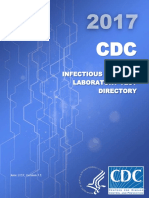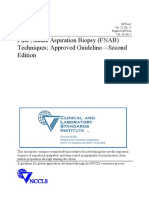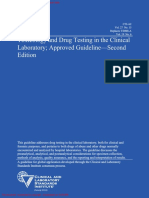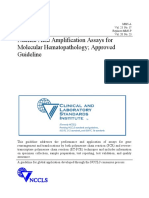GP33 Manual Clsi
GP33 Manual Clsi
Uploaded by
Gonzalez ArturoCopyright:
Available Formats
GP33 Manual Clsi
GP33 Manual Clsi
Uploaded by
Gonzalez ArturoOriginal Description:
Original Title
Copyright
Available Formats
Share this document
Did you find this document useful?
Is this content inappropriate?
Copyright:
Available Formats
GP33 Manual Clsi
GP33 Manual Clsi
Uploaded by
Gonzalez ArturoCopyright:
Available Formats
Lab Guidelines
& Standards
Who’s Who? Accuracy in Patient and Sample every year due to patient or specimen identification errors in-
Identification CLSI Approved Guideline volving the laboratory.
(GP33-A)
Meeting the Need
DOI: 10.1309/LMHI4JKXYWCWYUSF
Downloaded from https://academic.oup.com/labmed/article/41/7/436/2657641 by guest on 03 November 2020
The Clinical and Laboratory Standards Institute (CLSI)
Identification Practices recently published Accuracy in Patient and Sample Identifi-
In some healthcare settings, a patient may still be identi- cation: Approved Guideline (GP33-A). This clear, succinct
fied only by name and room number, hand-written on a plas- guideline describes the essential elements of the systems and
tic arm band. But in many of today’s hospitals and medical processes required to assure patient identification.
facilities electronic registration, barcodes, and auto-generated Chairholder of the document-development committee,
test-request forms are commonplace. More sophisticated sys- Sheila M. Woodcock, MBA, FCSMLS(D), QSE Consult-
tems, such as Radio Frequency ID and Biometrics, are also ing, brought to the task a background rich in both laboratory
available. Is this the time, then, for healthcare providers to standards and continuing education. Woodcock stresses the
finally stop worrying about patient and sample identification? importance of this subject. “Proper patient ID is fundamental
Not yet. As long as the implementation of these systems to quality laboratory services,” she says. “An accurate test re-
involves human intervention, the potential for error exists. sult on the wrong patient is at best of no value and, at worst,
could lead to incorrect or harmful treatment or intervention.”
Getting it Right The topic is so important, in fact, that at least 10 of
Basic to even the most rudimentary identification sys- the 12 quality system essentials outlined in CLSI document
tem is the proper and consistent use of patient identification HS01, A Quality Management System Model for Health
bands. A College of American Pathologists (CAP) Q-Tracks Care, touch upon patient identification.
study of identification band monitoring at 217 institutions To address the overlapping facets of an identification sys-
found an initial median identification band error rate of tem, the committee looked at every step in the process. “As we
7.4%. Most commonly, the identification band was missing broke each step into smaller and smaller segments,” Woodcock
entirely. A CAP Q-Probes study of identification errors in says, “we fleshed out certain areas to include every phase.”
primary and secondary labeling involving clinical laboratories GP33-A covers each stage, from registration and testing
reported 345 adverse patient events in a 5-week tracking pe- to reporting and archiving results. The language is aligned
riod at 120 institutions. It has been estimated that more than with that of ISO, and employs terms consistent with those
160,000 adverse patient events take place in the United States defined in the ISO 15189, ISO 17025, and ISO 9000 series
of standards, facilitating the efforts of healthcare pro-
viders using ISO documents and standards.
Registration and Sample Collection
Tables: The preexamination (preanalytic) phase in GP-33A
Table 1. Key Sample Labeling Principles begins with a suggested list of acceptable, unique identi-
Table 2. Patient Sample Rejection Policy Application fiers that patients might provide at registration, such as
Table 3. Example of a Generic Simplified FMEA Table Tailored to Patient Identification photo identification or date of birth. Disparities in the
Systems (All of the Situations Described Result in a Patient ID Error) inpatient and outpatient registration processes are noted.
High-risk situations are addressed, as are circumstances
Appendices: requiring special consideration, ie, patients with com-
Appendix A. Pre-examination Phase Process for Hospital Patients mon names, unresponsive and cognitively impaired
Appendix B. Sample Hospital Identification Band Policy patients, and patients too young to self-identify.
Appendix C. Sample Inpatient Identification Procedure CSF, biopsy, and other samples collected outside
Appendix D. Sample Procedure for Identifying Outpatients the laboratory can raise concern about the identifica-
Appendix E. Sample Procedure for Patient Identification in a Physician Office Laboratory tion process used during sample collection. Woodcock
Appendix F. Sample Procedure for Identifying Neonates stresses the importance of sharing the information in
Appendix G. Sample Labeling Policy and Procedures GP33-A with healthcare professionals both inside and
Appendix H. Examples of Examination Phase Process outside the lab. “Persons who collect samples off-site,
Appendix I. Post-examination Phase Process such as nurses and medical office staff,” she says, “need
Appendix J. Sample Training Checklist Form to be educated about other steps along the way and the
Appendix K. Sample Policy for the Misidentified or Unidentified Patient implications of identification errors during the collec-
tion process.”
436 LABMEDICINE ■ Volume 41 Number 7 ■ July 2010 labmedicine.com
Lab Guidelines & Standards
The application of a sample-rejection policy, address- barcoded. Such testing includes urinalysis microscopic exami-
ing the handling of both recollectable and nonrecollectable nations, hematology blood films, and blood banking proce-
samples, is illustrated in GP33-A. dures. GP33-A includes a flow chart for addressing samples
without barcode identification.
Automation
Because electronic test orders are transmitted directly to Results and Results Reporting
analyzers and barcoded samples are loaded in barcoded racks, While delta checks can identify unexpected results, this
the expectation for error is reduced in automated systems. mechanism is not perfect. Delta checks are performed automat-
Samples and aliquots, however, still pass through human ically by the instrument, but the parameters for these compari-
hands, and procedures should ensure proper identification sons are set by an individual. And delta checks can occur only
in every step of the process. if the patient has a previous test result in the system.
Result reporting, a process that once required the slow,
Barcoded and Non-barcoded methodical transcription of characters onto a paper form, is
Not every sample is barcoded; some facilities simply lack now accomplished by the mere tapping of a fingertip on a
the ability to barcode. In addition, laboratories perform test- keyboard: Accept…Enter. A simple lapse in concentration or
Downloaded from https://academic.oup.com/labmed/article/41/7/436/2657641 by guest on 03 November 2020
ing that does not include barcoding in the identification of a slip on the keyboard could cause the operator to accept an
the sample during examination, even if the initial sample was unacceptable result.
Related CLSI Reference Materials
EP18-A2 Risk Management Techniques to Identify and Control Laboratory Error Sources; Approved Guideline -
Second Edition (2009). This guideline describes risk management techniques that will aid in identifying,
understanding, and managing sources of failure (potential failure modes) and help to ensure correct results.
Although intended primarily for in vitro diagnostics, this document will also serve as a reference for clinical
laboratory managers and supervisors who wish to learn about risk management techniques and processes.
GP21-A3 Training and Competence Assessment; Approved Guideline - Third Edition (2009). This guideline provides
background information and recommended processes for the development of training and competence
assessment programs that meet quality and regulatory objectives.
GP32-A Management of Nonconforming Laboratory Events; Approved Guideline (2007). This guideline provides
an outline and the content for developing a program to manage a health care service’s nonconforming
events that is based on the principles of quality management and patient safety.
H03-A6 Procedures for the Collection of Diagnostic Blood Specimens by Venipuncture; Approved Standard -
Sixth Edition (2007). This document provides procedures for the collection of diagnostic specimens by
venipuncture, including line draws, blood culture collection, and venipuncture in children.
H04-A6 Procedures and Devices for the Collection of Diagnostic Capillary Blood Specimens; Approved Standard -
Sixth Edition (2008). This document provides a technique for the collection of diagnostic capillary blood
specimens, including recommendations for collection sites and specimen handling and identification.
Specifications for disposable devices used to collect, process, and transfer diagnostic capillary blood
specimens are also included.
H11-A4 Procedures for the Collection of Arterial Blood Specimens; Approved Standard - Fourth Edition (2004).
This document provides principles for collecting, handling, and transporting arterial blood specimens to
reduce collection hazards and ensure the integrity of the arterial specimen.
HS01-A2 A Quality Management System Model for Health Care; Approved Guideline - Second Edition (2004).
This document provides a model for providers of health care services that will assist with implementation
and maintenance of effective quality management systems.
MM13-A Collection, Transport, Preparation, and Storage of Specimens for Molecular Methods; Approved Guideline
(2005). This document provides guidance related to proper and safe biological specimen collection and
nucleic acid isolation and purification. These topics include methods of collection, recommended storage
and transport conditions, and available nucleic acid purification technologies for each specimen/nucleic acid type.
*CLSI documents are continually reviewed and revised through the CLSI consensus process; therefore, readers should refer to the most current editions.
labmedicine.com July 2010 ■ Volume 41 Number 7 ■ LABMEDICINE 437
Lab Guidelines & Standards
Validation of Identification Systems In keeping with CLSI’s other documents, GP33-A strives
Identification systems can be validated by process map- to provide guidance in the standardization of processes across
ping, ie, delineating each step of the process and each activity the healthcare community.
involved in patient identification. Validation processes can
then target any weak spots. GP33-A includes an example of
1. Howanitz PJ, Renner SW, Walsh MK. Continuous wristband monitoring over 2
a Failure Mode and Effects Analysis (FMEA). The FMEA is years decreases identification errors. Arch Pathol Lab Med. 2002;126:809-815.
used to identify a potential failure, determine its consequences 2. Valenstein PN, Raab S, Walsh M. Identification errors involving clinical
and review the control measures necessary to prevent or detect laboratories. Arch Pathol Lab Med. 2006;130:1106-1113.
that failure. 3. Ford A. Catching ID errors where it counts - in the lab. CAP Today.
2005;19:34-40.
GP33-A
There’s no disputing the fact that modern identification
systems far exceed those in place during the last century. But
Jon DeMartino, MLT (ASCP) is a freelance writer
no matter how sophisticated and technologically foolproof we
and creative consultant who can be reached at
Downloaded from https://academic.oup.com/labmed/article/41/7/436/2657641 by guest on 03 November 2020
make these systems, they remain vulnerable to human error.
jonde1@juno.com.
The authors of this well-thought-out document have disas-
sembled the complex processes in a patient identification system CLSI is a global, nonprofit organization promoting
and provided a logical guideline for use by healthcare providers the development and use of voluntary consensus standards
who design, select, implement, monitor, and evaluate these sys- and guidelines within the health care community.
tems and for those who instruct others in their use.
438 LABMEDICINE ■ Volume 41 Number 7 ■ July 2010 labmedicine.com
You might also like
- User Protocol For Evaluation of Qualitative Test Performance Approved GuidelineNo ratings yetUser Protocol For Evaluation of Qualitative Test Performance Approved Guideline51 pages
- Laboratory Total Quality Management for Practitioners and Students of Medical Laboratory ScienceFrom EverandLaboratory Total Quality Management for Practitioners and Students of Medical Laboratory Science5/5 (4)
- WASH Evaluation Solar Powered Water Supply Systems Somalia 2016-003100% (1)WASH Evaluation Solar Powered Water Supply Systems Somalia 2016-00360 pages
- A Review of Medical Errors in Laboratory Diagnostics and Where We Are TodayNo ratings yetA Review of Medical Errors in Laboratory Diagnostics and Where We Are Today4 pages
- Sample: Interference Testing in Clinical Chemistry Approved Guideline-Second EditionNo ratings yetSample: Interference Testing in Clinical Chemistry Approved Guideline-Second Edition12 pages
- Preliminary Evaluation of Quantitative Clinical Laboratory Methods Approved Guideline-Second EditionNo ratings yetPreliminary Evaluation of Quantitative Clinical Laboratory Methods Approved Guideline-Second Edition75 pages
- Procedures For The Collection of Diagnostic Blood Specimens by Venipuncture Approved Standard-Fifth EditionNo ratings yetProcedures For The Collection of Diagnostic Blood Specimens by Venipuncture Approved Standard-Fifth Edition52 pages
- Free Download CLSI EP26 User Evaluation of Between Reagent Lot VariationNo ratings yetFree Download CLSI EP26 User Evaluation of Between Reagent Lot Variation20 pages
- Quality Manual: Table of Contents: GeneralNo ratings yetQuality Manual: Table of Contents: General7 pages
- Protection of Laboratory Workers From Occupationally Acquired Infections Approved Guideline-Third EditionNo ratings yetProtection of Laboratory Workers From Occupationally Acquired Infections Approved Guideline-Third Edition124 pages
- Terastandard - Clsi Ep 23 A Vjyf6dp5cq 2011 1524071287100% (1)Terastandard - Clsi Ep 23 A Vjyf6dp5cq 2011 1524071287124 pages
- Laboratory Design Approved Guideline - Second Edition: GP18-A2 Vol. 27 No. 7 Replaces GP18-A Vol. 18 No. 3No ratings yetLaboratory Design Approved Guideline - Second Edition: GP18-A2 Vol. 27 No. 7 Replaces GP18-A Vol. 18 No. 3120 pages
- Clinical Laboratory Management-Springer (2024)No ratings yetClinical Laboratory Management-Springer (2024)276 pages
- Training and Competence Assessment Approved Guideline-Second EditionNo ratings yetTraining and Competence Assessment Approved Guideline-Second Edition60 pages
- Toxicology and Drug Testing in The Clinical Laboratory Approved Guideline-Second EditionNo ratings yetToxicology and Drug Testing in The Clinical Laboratory Approved Guideline-Second Edition68 pages
- HLG Automata 150428233016 Conversion Gate02100% (1)HLG Automata 150428233016 Conversion Gate02111 pages
- Sigma Metric QMS in Medical Lab - Palembang Indonesia100% (1)Sigma Metric QMS in Medical Lab - Palembang Indonesia76 pages
- Development of in Vitro Susceptibility Testing Criteria and Quality Control ParametersNo ratings yetDevelopment of in Vitro Susceptibility Testing Criteria and Quality Control Parameters84 pages
- Procedure: Quality Assurance Policy Version 5 Quality Assessment Policy Version 3 Prepared by Date Adopted Supersedes Procedure #No ratings yetProcedure: Quality Assurance Policy Version 5 Quality Assessment Policy Version 3 Prepared by Date Adopted Supersedes Procedure #16 pages
- Reference Intervals - Direct Priori MethodNo ratings yetReference Intervals - Direct Priori Method5 pages
- Use of Fresh Blood For Quality Control: Erythrocyte Sedimentation RateNo ratings yetUse of Fresh Blood For Quality Control: Erythrocyte Sedimentation Rate6 pages
- Guidelines For Safe Work Practices in Human and Animal Clinical Diagnostic LaboratoriesNo ratings yetGuidelines For Safe Work Practices in Human and Animal Clinical Diagnostic Laboratories352 pages
- COLLECTION OF BLOOD SPECIMENS MANUAL 2018-2020 - For Lab Guide PDFNo ratings yetCOLLECTION OF BLOOD SPECIMENS MANUAL 2018-2020 - For Lab Guide PDF27 pages
- Gp33a - Sample - PDF PASOS DE ANALSIS CLINICOS PDFNo ratings yetGp33a - Sample - PDF PASOS DE ANALSIS CLINICOS PDF12 pages
- What Constitutes A Correctly Labeled Specimen?: Laboratory Medicine October 2011No ratings yetWhat Constitutes A Correctly Labeled Specimen?: Laboratory Medicine October 20113 pages
- Results Framework and M&E Guidance Note: Opspq April 9, 2013No ratings yetResults Framework and M&E Guidance Note: Opspq April 9, 201323 pages
- State Scholarship Portal (Post Matric) Acknowledgement 2021-22No ratings yetState Scholarship Portal (Post Matric) Acknowledgement 2021-222 pages
- Teaching Arts in The Elementary Grades: OgdimalantaNo ratings yetTeaching Arts in The Elementary Grades: Ogdimalanta12 pages
- San Miguel Corporation and A. Soriano Corporation100% (3)San Miguel Corporation and A. Soriano Corporation4 pages
- Learning Styles of Social Studies 4th YearNo ratings yetLearning Styles of Social Studies 4th Year14 pages
- Manufacturing Trading and Profit and Loss Account For The Year Ended 31 March 2013 M. MichealNo ratings yetManufacturing Trading and Profit and Loss Account For The Year Ended 31 March 2013 M. Micheal1 page
- Salient Feature of The Constitution of IndiaNo ratings yetSalient Feature of The Constitution of India16 pages
- NIKE Strategies With Maslow's Hierarchy of Needs: Made byNo ratings yetNIKE Strategies With Maslow's Hierarchy of Needs: Made by16 pages
- Extraterritorial Congressional OversightNo ratings yetExtraterritorial Congressional Oversight21 pages
- Sacred Heart Academy of Pasig: Lesson Plan in Applied EconomicsNo ratings yetSacred Heart Academy of Pasig: Lesson Plan in Applied Economics3 pages
- Ecommerce Business Proposal: (Web Design)No ratings yetEcommerce Business Proposal: (Web Design)35 pages
































































































